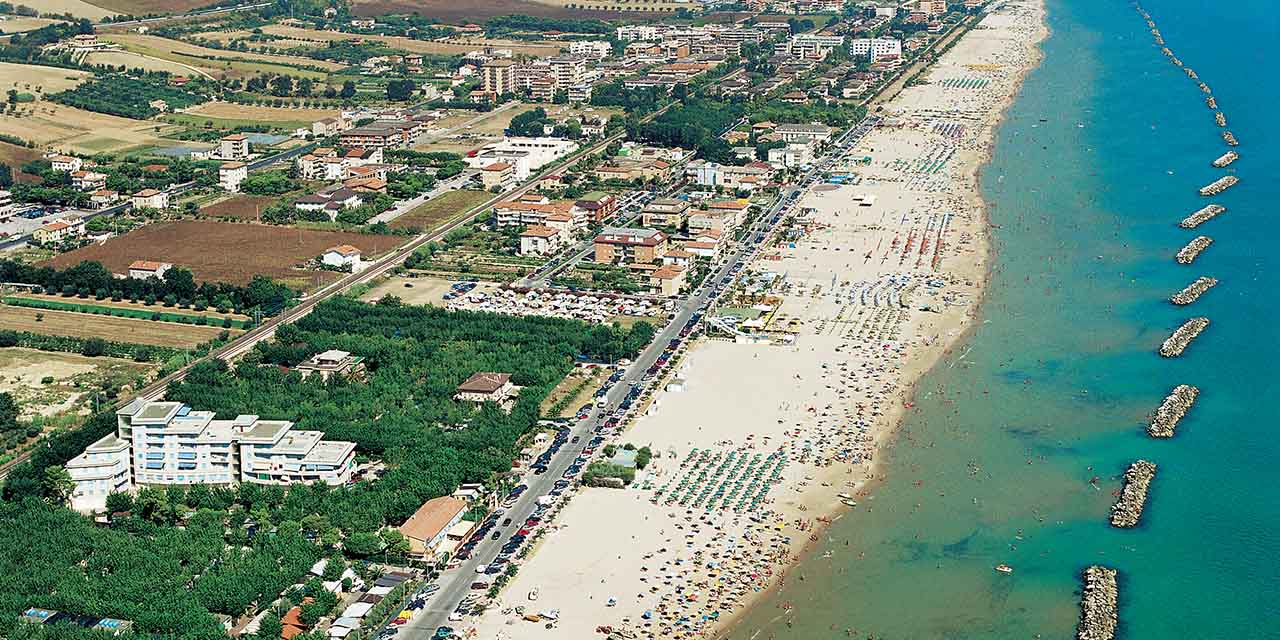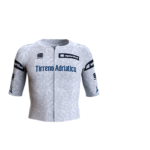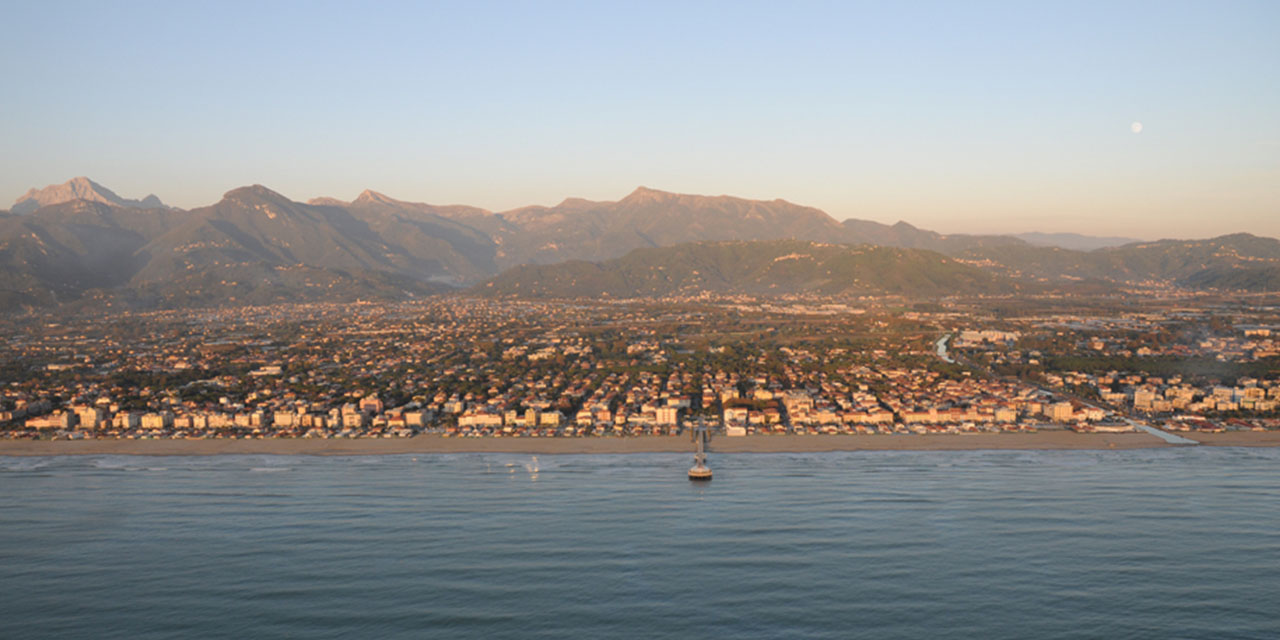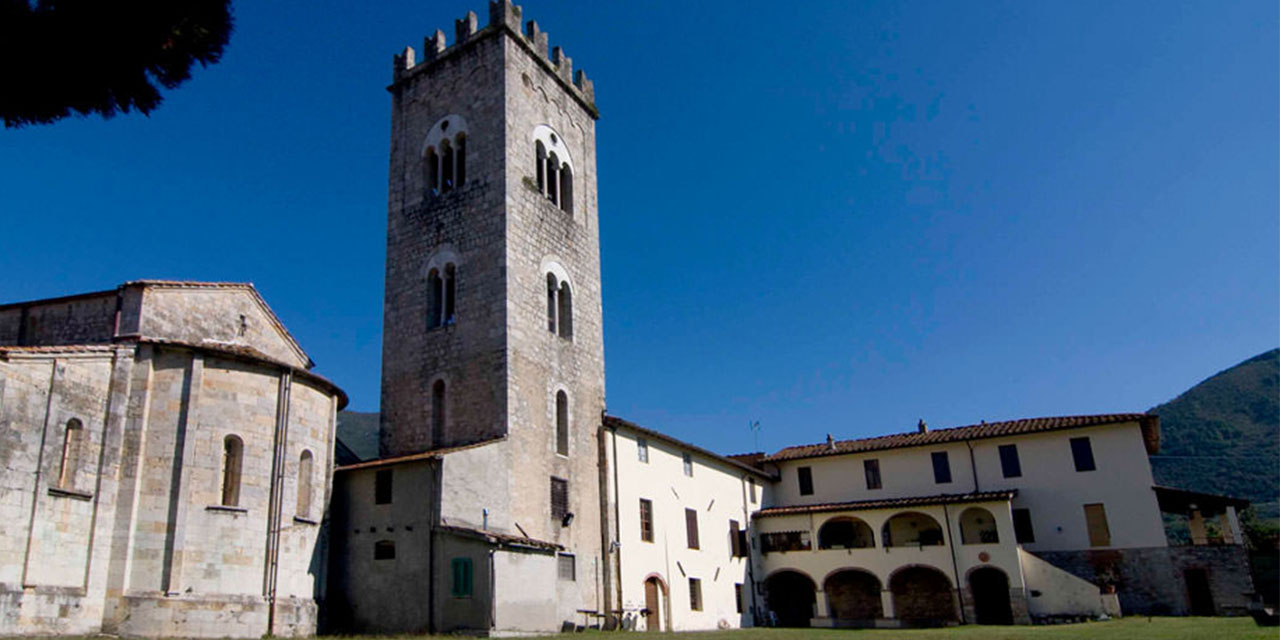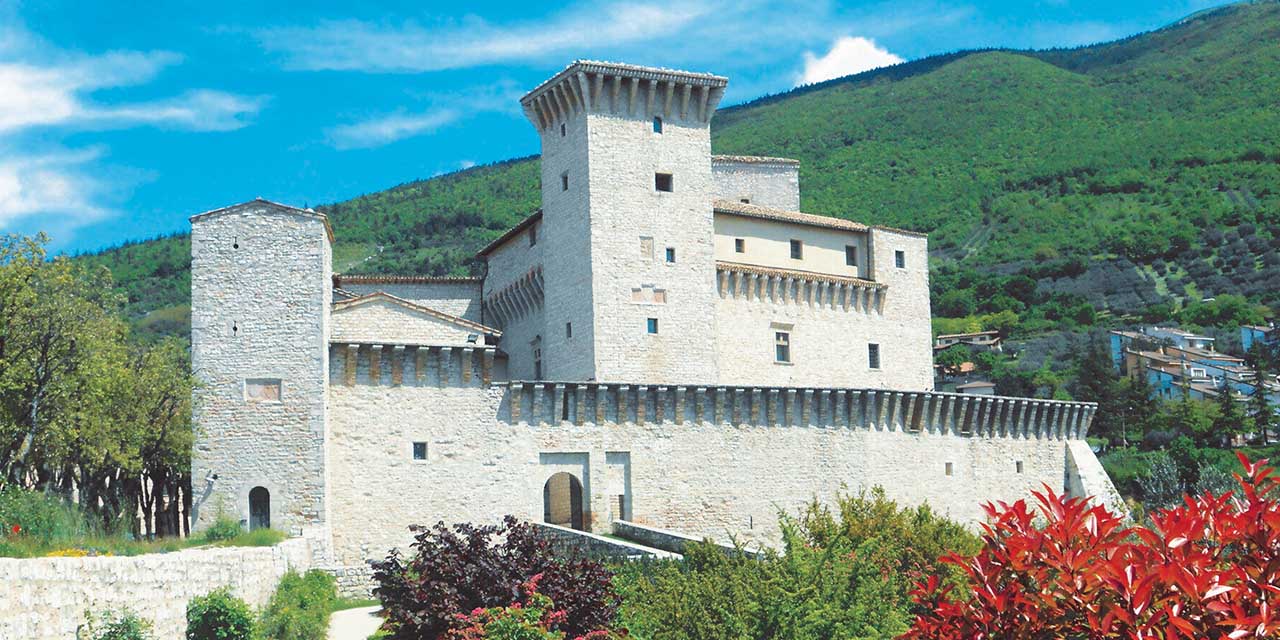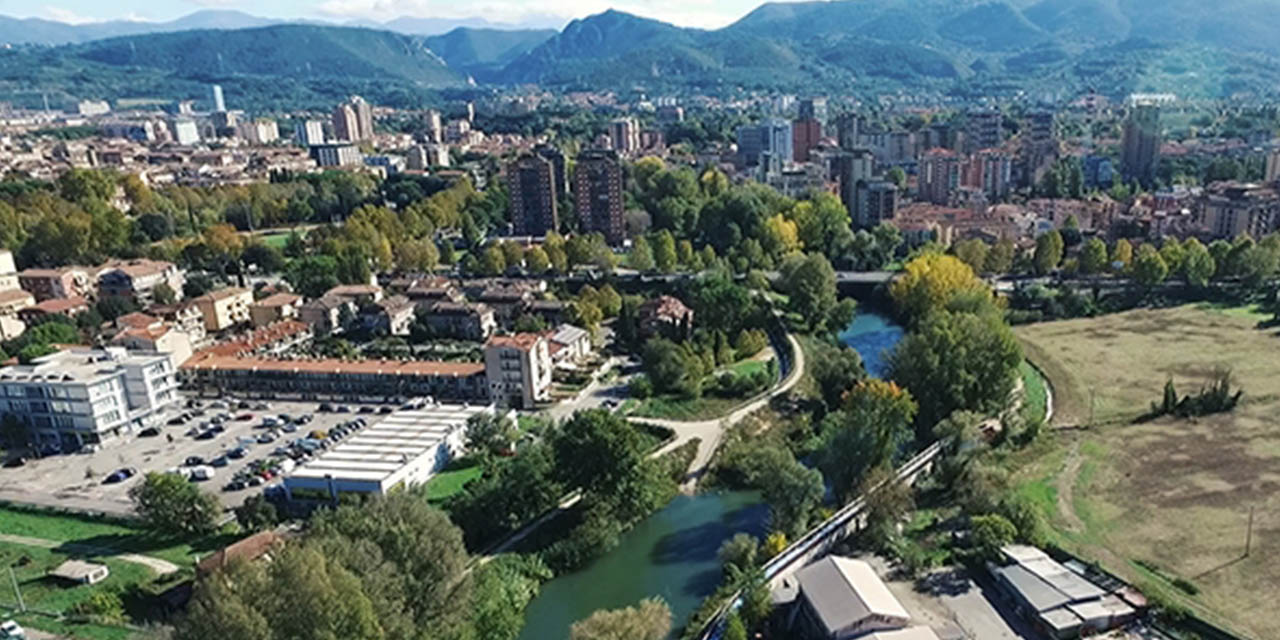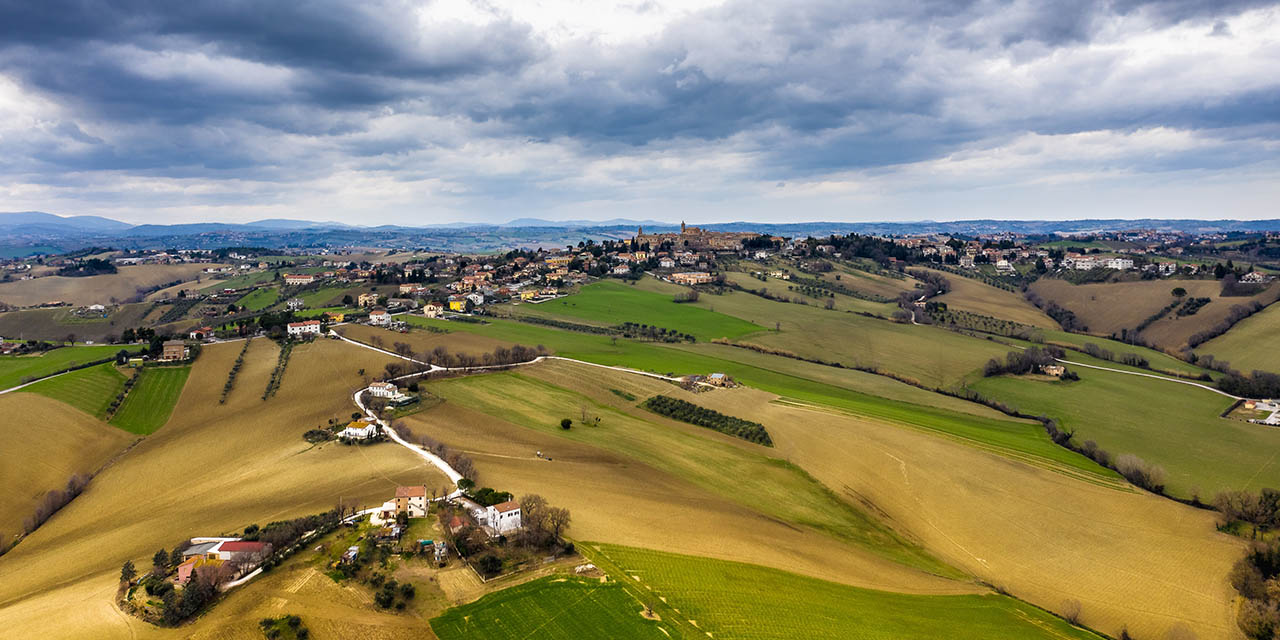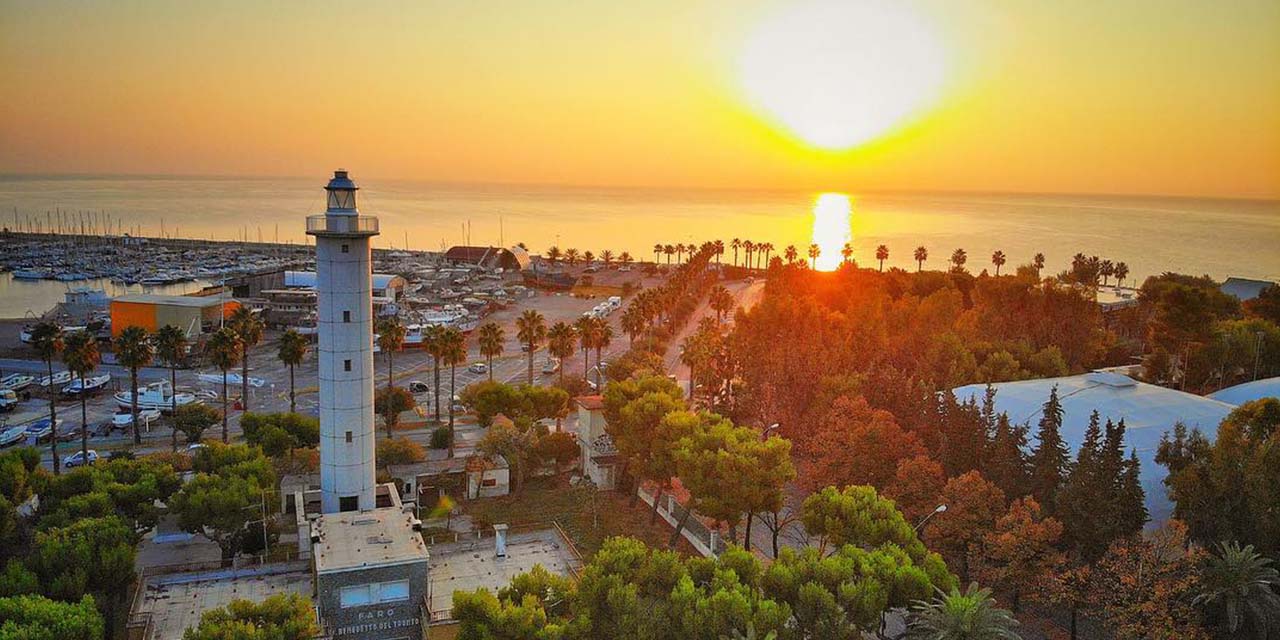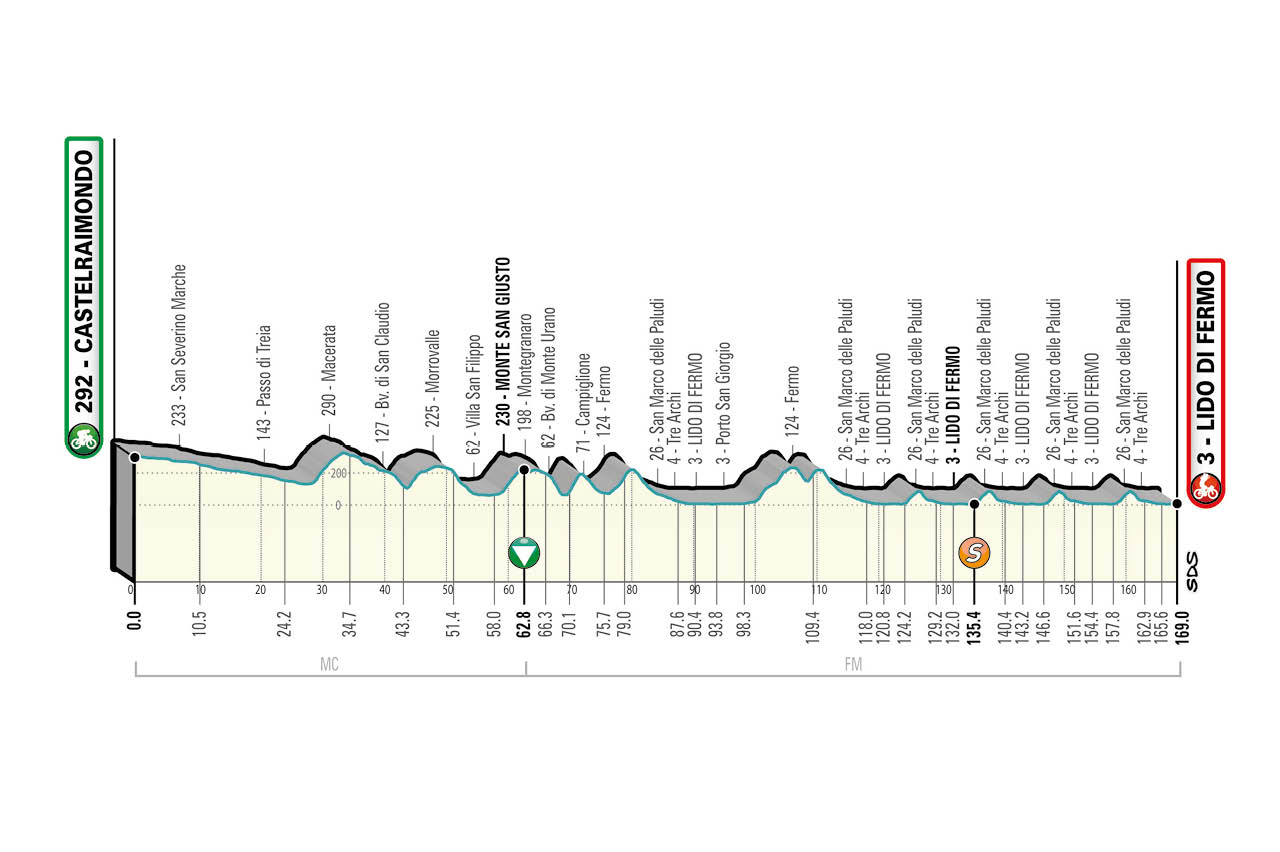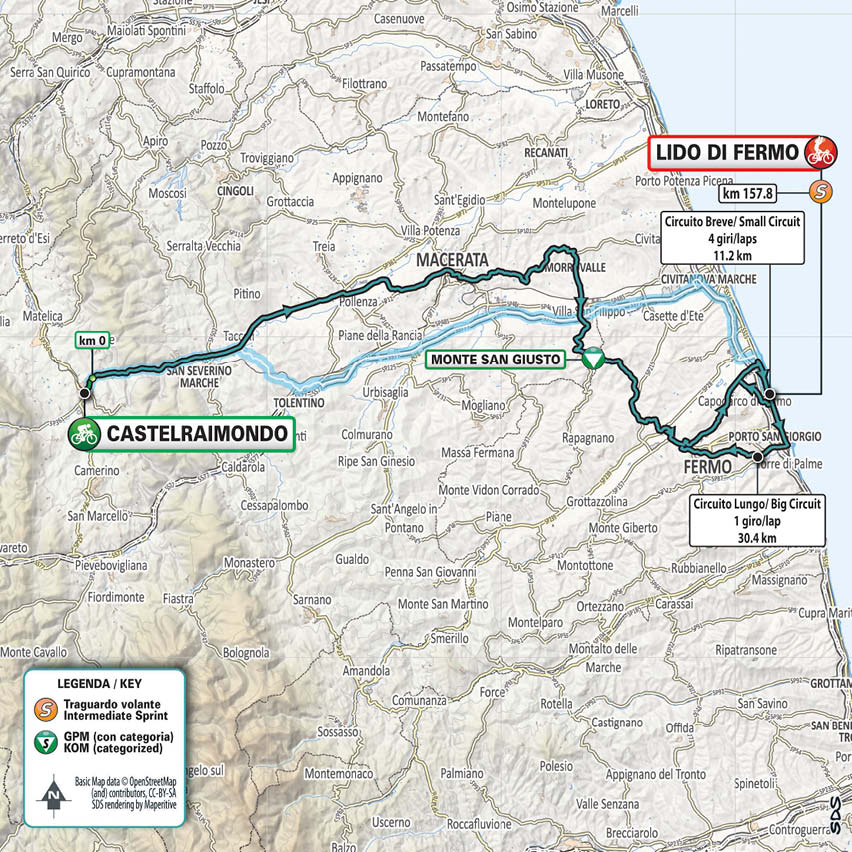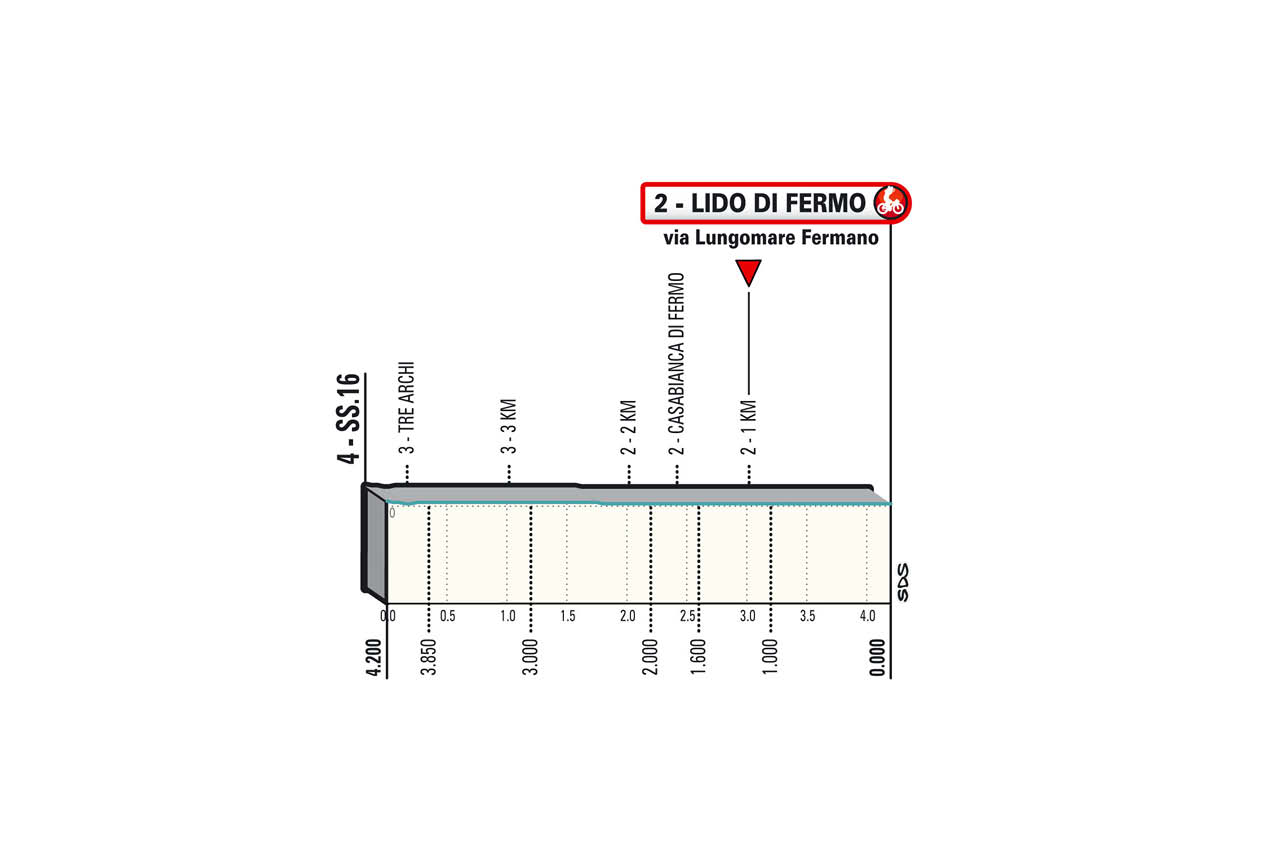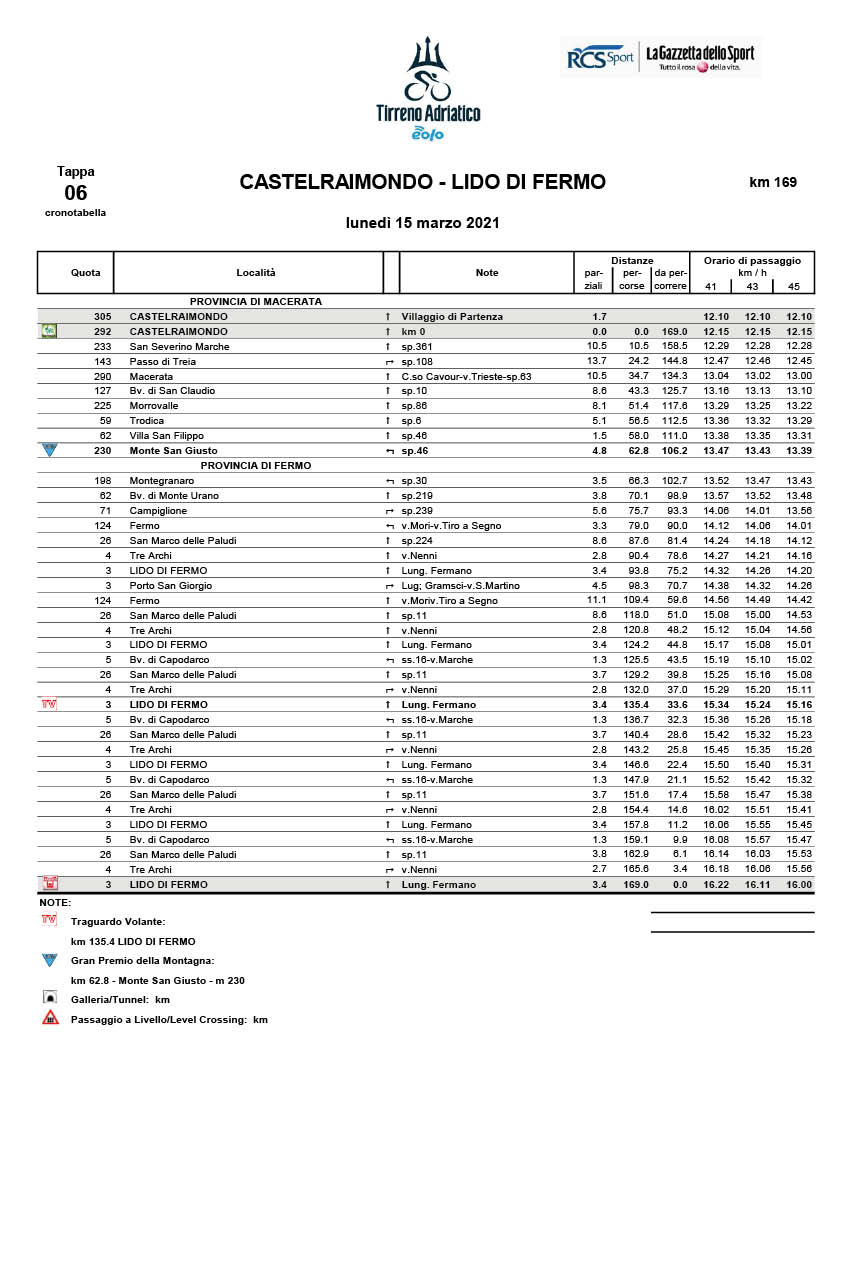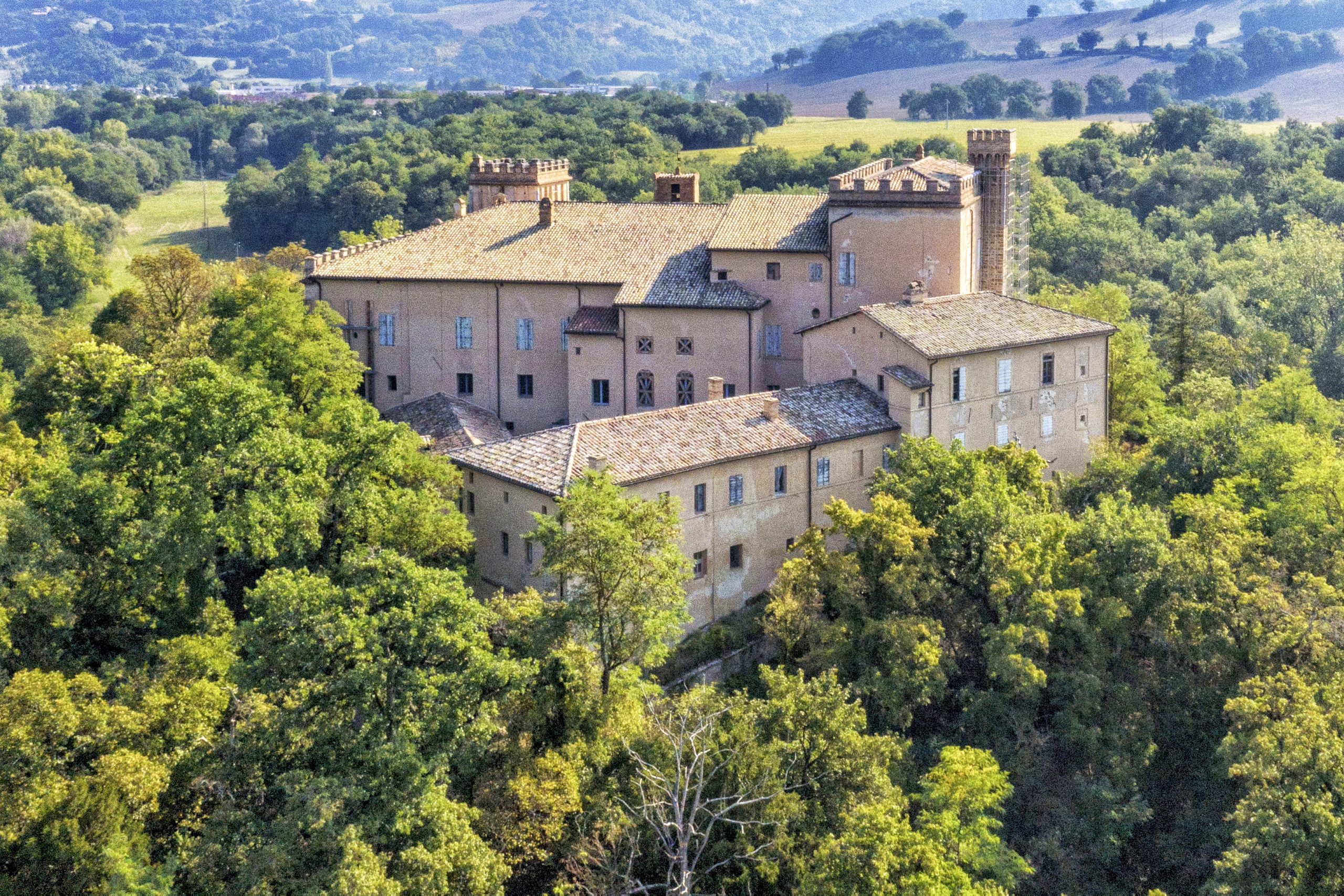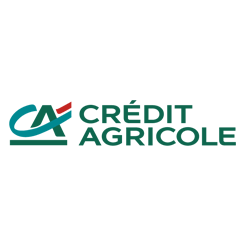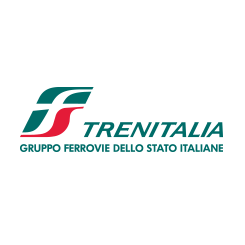profile
map
technical info
The Route
Wavy at first, the route then levels out and eventually takes an uncomplicated closing circuit (one large lap and 4 small laps). Upon reaching the Fermo area, the stage passes over the finish and takes the long lap, climbing all the way to Fermo, dropping towards Tre Archi and passing over the finish again.
Final Kilometres
Four short laps follow, featuring a brief ascent up the first kilometre of the Capodarco climb. The route then heads towards San Marco, eventually reaching the finish. The home straight is on flat tarmac (8.5 m wide).
start / finish


final kilometres
itinerary timetable
tourist info
Host city:
Castelraimondo
Touristic information
A village of about 5,000 inhabitants with an agricultural and industrial vocation, Castelraimondo is a hilly center of medieval origin and a perfect example of combination of old and new architectures. In the past it was also known as Lu Cassero. The latter denomination is due to the distinctive monument of the town, dominated by an imposing fourteenth-century tower of 37 meters in height, surrounded by an integre double moat, which was part of the Raimondo Castle, a military fortress once equipped with mighty bastions built by the Da Varano of Camerino dinasty. Later, other portions of the ancient building were incorporated into the parish house.
The “Infiorata” festival is very famous: it is held on the occasion of the Corpus Domini feast, with many flowery and colorful paintings that decorate the streets of the town.
Gastronomy
The Vincisgrassi is the specialty of the Marche cuisine, in particular of the Macerata area; it is a baked pasta similar to lasagna, from which it differs in the type of meat sauce, prepared with coarsely cut and not minced meat, and in the bechamel, which is more compact. Furthermore, the addition of spices such as cloves and nutmeg is made more perceptible, giving the dish aromatic notes. It was said that it had been prepared for the first time in honor of the Austrian general Windisch Graetz, who standed out himself in the defense against the Napoleonic troops in 1799. It is considered the bank holyday dish, which is prepared on the most important occasions of the year.
Typical of this area is also the Crescia Fogliata, a golden color and rolled shape dessert, with a filling based on seasonal fruit and dried fruit, mainly apples and raisins, which is found throughout the area of Macerata with variations and adaptations based on local traditions.
Bevande
Verdicchio di Matelica is a truly delicious wine, which recalls chamomile in colors and tones. It can be tasted as an aperitif and goes very well with fish-based dishes, appetizers, delicate white meats and main courses. It is a wine rich in aromas of acacia and broom, composed only with Verdicchio grapes; it is a basic wine, but also appreciated by the most demanding taster, as it is dry, savory and fresh in acidity. The numerous and welcoming wineries in the area still maintain the centuries-old tradition of making wine and also introduce innovation. The careful production and care of the raw material completely enhance the flavors that expert tasters always want to find in this precious nectar.
Points of interest
In addition to the imposing Cassero Tower, in the historic center you can visit the Church of the Holy Family, which is worth seeing for its original shape, with a roof supported by a pair of V-shaped beams resting on richly decorated columns. The internal nave leads to the apse, where you can admire the artistic tabernacle enhanced by the canvas depicting the Virgin and Child. The Church of San Giovanni, with its remarkable architectural details, such as the rich section of round brick arches that form the backdrop to the large rose window, is really beautiful.
The Civic Museum is located in the Town Hall attic, an elegant neoclassical building of the late nineteenth century, next to the medieval Cassero Tower. It was established in 1986 thanks to the donations made by master Ugo Bottacchiari’s daughter, including musical compositions, relics, memoirs and manuscripts, together with the musical rights of the works published in Italy. The documentary collection consists of the opera repertoire of the musician, while most of his writings have been donated to the Library of the ‘G. Verdi’s Conservatory in Milan.
A short distance from the town is also the splendid Castle of Lanciano, built between 1350 and 1418, which is now an unique residence-museum, due to the abundance of furnishings, paintings and historical references. It houses the Maria Sofia Giustiniani Bandini Museum, which contains a collection of paintings and decorated rooms with stucco. From its crenellated towers you can enjoy a wonderful view over the surrounding hilly landscape, colorful in all shades of green.
The Municipal Theater is also noteworthy: it has a horseshoe plan, two side boxes and a large balcony, a notable example of Fascist architecture. The stucco decorations embellish the proscenium and the parapet, while the ceiling is decorated in tempera and surrounded by stuccoed frames, where the allegory that symbolizes “Fascism that illuminates workers and protects families” is depicted.
The town is particularly known for the traditional Infiorata, on the occasion of the “Corpus Domini” festival. This ancient and suggestive event, documented by the parish archives as early as 1500, takes place every year in June, when the streets of the historic center, and in particular part of Corso Italia, are fully covered with splendid floral compositions with the most varied themes and colors. This historical re-enactment is made possible thanks to the meticulous and excited contribution of hundreds people, organizations, businesses and families, who still silently and generously contribute to handing down this form of art and collective expression of faith.
We must eventually mention Pista Feggiani, an international minibike circuit, an ideal place for sport lovers.
Lido di Fermo
Touristic information
Fermo is one of the most alluring of the hilltowns of the southern Marche; it was so called by the ancient Romans probably because of its tufaceous soil.
The city is now divided into two parts: the historical one, that developed around around the top of a hill, which has remained almost intact over the centuries, with the splendid medieval center rich of Renaissance masterpieces, and a more recent part.
The Municipality of Fermo includes also 3 km of coastline south of Porto San Giorgio, called Marina Palmense, and 4 km of coastline to the north, including Lido of Fermo, Casabianca and Lido San Tommaso, many of which have been awarded with the Blue Flag label, thanks to clean water and a wide range of accommodation facilities. The area is quiet and full of leisure and sport facilities, bars, restaurants and discos. The two resorts are surrounded by verdant and luxuriant hills that protect them from the winds. For this reason, the climate is mild throughout the whole year.
Gastronomy
The most famous specialty of Fermo is the so called Maccheroncini of Campofilone I.G.P., Italy’s finest egg pasta, made in Campofilone. They are famous worldwide for their subtle texture and flavour. The delicate strands of maccheroncini di Campofilone are made entirely from eggs and durum wheat flour without any added water, and ten eggs are used for every kilogram of flour. In 2013 the Maccheroncini of Campofilone gained an I.G.P. (protected geographical indication). They are perfect both with gravy and fish sauce.
Thanks to the high protein value and organoleptic characteristics, this semolina pasta is particularly appreciated and commercialized around the world.
Among the best-known products, we must also mention the Caciotta Fermana, produced with cow’s milk or with the addition, in variable proportions, of local sheep or goat’s milk. The rind is usually dark ivory in color, spotted with brown in case of using walnut leaves. Compared to the Casciotta of Montefeltro, the one from Fermo is normally eaten fresh. The flavor varies according to the seasoning, from sweet sour to pasty.
Frustingo is the typical local dessert: the dough is made of dried figs, raisins, almonds, walnuts, cooked wine, flavored with the addition of cocoa, coffee, rum, grated orange and lemon peel, candied fruit and spices such as cinnamon and nutmeg.
Bevande
The cooked wine, well known as ‘vino cotto’, is a sublime dessert wine from the south of the region; it is made by boiling down fresh grape must in copper cauldrons – hence cotto or “cooked”. The production area of this traditional wine is very extensive, including most of the provinces of Macerata, Fermo and Ascoli Piceno. To obtain the classic sweet cooked wine, the initial quantity of must is reduced by a variable percentage between 30 and 50%. For a drier result, however, the duration of boiling is shortened. The dry version is generally used as a table wine, with combinations that vary according to the alcohol concentration degree. The sweet version, on the other hand, can be considered a dessert wine, perfect with pies, donuts and rustic biscuits.
Points of interest
The heart of Fermo is the Renaissance Piazza del Popolo, formerly Piazza Grande, with the sixteenth-century Palazzo dei Priori, which houses the Civic Art Gallery, boasting remarkable paintings from the Venetian and Marche schools, as well as the precious canvas depicting the ‘Nativity’ by Rubens, and the spectacular Mappamondo Hall, which takes its name precisely from the one designed by the cartographer Moroncelli of Fabriano in 1713. The archaeological section ‘From Villanoviani to Piceni’ can be visited in the same palace. Further outstanding buildings surrounding Piazza del Popolo are: the Palace of Studies, which houses the ‘Spezioli’ municipal library, one of Italy’s most important libraries in terms of consistency, and the Apostolic Palace, built in 1532 as the residence of the governors and papal legates. Fermo’s pride is also the magnificent historical theatre, Teatro dell’Aquila, one of Marche’s most impressive theatres built in the eighteenth century.
Also worthy of note are the underground cisterne romane (roman pools) which comprise thirty magnificently preserved underground chambers built between 41 & 60 BC to conserve and purify the town’s water supply, and regarded as the finest example of their kind in Italy. Once reached the Girfalco hill, you can enjoy a stunning view over the surrounding valleys and admire the Cathedral of the Assumption, with the beautiful Romanesque-Gothic façade built in 1227.
During the visit you can’t miss the Church of San Francesco, which boasts the remains of frescoes by Giuliano of Rimini, one of the most important followers of Giotto; the concathedral church of San Domenico, which was built in 1233 upon the ruins of the Church of San Tommaso of Canterbury, and finally the Church of Sant’Agostino, one of the best known religious buildings in the area of Fermo, embellished with frescoes by Rimini, Fabriano and Bolognese schools.
Palazzo Paccarone is worth a visit too: it houses Tommaso Salvadori Science Museum, which includes the ornithological collection, and the Silvio Zavatti Polar Museum.
The most important event, the Palio della Cavalcata dell’Assunta, is celebrated on August 15.
During the year, Tipicità Festival celebrates the flavors and other excellences of Made in Marche.


